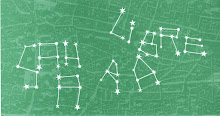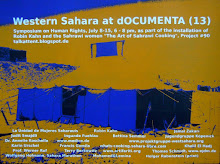Texto del presentación firmado por el autor del cartel:
ART Intifada does
not only depict what we are doing as artists, in fact it brings the pains and
the sufferings of the Saharawi people in front of the world through the
artistic expression of color, shape and thought. Art is revolutionizing the
revolution, there is no limit of what can art do.
In November 2010, Saharawi civilians went out
of the city of Laioun, now occupied by Morocco. They organized a peaceful
protest in Gdaim Izik –the place where the Saharawi families set up tents
numbering thousands. The Gdaim Izik camp may not have lived long, for the Moroccan
army crashed it down very soon, but it marked two significant factors in the
conflict.
First, the presence of an unquestionable will
within the Saharawi people to reach their goal of independence. It’s difficult
to restrain these people when they have freely wandered the vast desert for
centuries. They are free people by nature. Second, the means with which they
fight for this goal. These means are peaceful in the sense that they are very
Saharawi too. The tent; a shelter and a refuge for the Saharawi nomadic people
of yesterday, now has a role to play in today’s Saharawi life too; the same
object that protected them from the hardships of nature, today stands firm
beside them. It became a symbol of protest as visible in the protest arena as
the Saharawi people themselves. The tent has changed from a passive object only
to be dwelled or to be sought as a cover from the sun and the wind to a very
active object of its own. Now it participates and takes action just as actively
as the people who live in it.
Therefore,
ART Intifada is truly igniting the scene. The tent, the camel, the Melhfa and
the Darraa along with their different colors, shapes and representations are
all part of the Intifada. The presence of these traditions, as forms of art, is
the ART Intifada.
Mohamed Sulaiman
Smara, 2013






